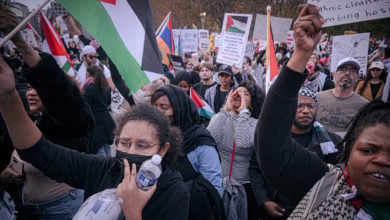Inspired by the popular revolutions in Tunisia and Egypt, the courageous people of Bahrain and Yemen have stood up to fight back against their own repressive governments, facing violent attempts at suppression of their movements. Both countries are ruled by brutal, undemocratic puppet regimes of the United States. In Bahrain, the protest movement started out calling for reform of the regime, but quickly escalated to a wholesale movement against the monarchy.
The absolute monarchy of King Hamad ibn Isa Al Khalifa in Bahrain has been fully backed by the United States for its entire existence. The majority Shia population is horribly oppressed and disenfranchised in every way. The National Assembly lacks legislative powers, political opposition is brutally suppressed and until 2002 women could not vote.
Yet the United States has continued to prop up the monarchy in exchange for access to the country’s substantial oil wealth. Bahrain is also an international banking center and is home to the U.S. Navy’s Fifth Fleet, which is instrumental to the imperialist strategy for dominating the Persian Gulf.
Bahraini protest movement
Starting in early February, hundreds of Bahrainis demonstrated in solidarity with the Egyptian people as they forced Hosni Mubarak from power. By the middle of the month, the movement had swelled to include tens of thousands.
On Feb. 14, mass demonstrations centered in the capital and most populous city in the country, Manama, and extended far into the villages and countryside all across the country. Days later, protesters set up a tent city, taking effective control of the Pearl Roundabout in the heart of Manama.
The king’s regime responded with a massive police presence, resulting in clashes that left many demonstrators killed and injured. While the protesters slept early in the morning of Feb. 17, riot police moved in to forcibly remove their encampment. Hundreds were injured and at least five people were killed, including a two-year-old girl.
In an attempt to appease the growing movement, the king released hundreds of political prisoners and dismissed several government ministers. When the concessions failed to break the will of the people, the government responded with still more police crackdowns.
By March, the protest demands had escalated from mere reforms to calls for the abolition of the monarchy and the establishment of a democratic republic.
On March 14, the Gulf Co-operation Council—made up entirely of loyal U.S. puppet regimes, including Saudi Arabia, Kuwait, Oman, Qatar, the United Arab Emirates and Bahrain—agreed to send in hundreds of Saudi military and UAE police to put down the protests.
The following day, the king declared a three-month state of emergency and martial law. At least three protesters were killed and many were injured by being run over by tanks at high speed as Pearl Square was cleared by riot police.
Yemen
Meanwhile, the United States has been bombing Yemen since at least 2009 with the full approval of Ali Abdullah Saleh, now in his 33rd year as president. A U.S.-backed airstrike in December of that year killed 42 civilians, the vast majority of whom were women and children.
In 2010, the U.S. government transferred $155 million in military aid to help the Saleh regime in its fight against two separate rebel movements: the Houthi tribe in the north and a secessionist movement in the southern region of the country, which was a socialist state prior to 1990.
Even before the Egyptian revolution began, thousands in Yemen had begun protesting to demand the ouster of Saleh, inspired by the revolution in Tunisia. A major demonstration of tens of thousands took place in Sana’a on Jan. 27.
Saleh attempted in vain to stem the tide of the rebellion, announcing he would neither run for reelection in 2013 nor pass power to his son. But the protesters refused to accept his concessions based on past empty promises. In 2006, Saleh had declared he would step down, only to later attempt to amend the constitution to make himself president for life.
In a protest dubbed a “Friday of Fury” on Feb. 18, tens of thousands more Yemenis demonstrated in the cities of Sanaa, Taiz and Aden. The massive crowd marched towards the presidential palace chanting anti-government slogans. By the end of the month, the protest movement had swelled still further into the hundreds of thousands.
On March 18, protesters in Sana’a were fired upon with live ammunition from overlooking rooftops. At least 45 people were killed and hundreds more were injured. In response, hundreds of ruling party and government cabinet members, ministers, high-ranking military officers and members of parliament resigned. Even Yemeni army troops, deployed to crush the protests, began to defect to the opposition.
Saleh declared on March 22 that he would be willing to step down by the end of the year, but the opposition rejected the offer, restating their demands for his immediate ouster. The following day, parliament enacted a 30-day emergency law that suspended the constitution, allowed media censorship, banned street protests and gave security forces far-reaching powers to arrest and detain suspects.
The situation on the ground in both Bahrain and Yemen features a government that is firing on its own citizens—precisely the conditions in Libya that the U.S. claims have led it to intervene militarily, to “protect civilians” and “support democracy.” Considering the apparent similarities, why has U.S. action in Yemen and Bahrain been limited to mealy-mouthed calls for “maximum restraint” on all sides?
A March 22 New York Times Editorial cynically argued: “Libya is a specific case: Muammar el-Qaddafi is erratic, widely reviled, armed with mustard gas and has a history of supporting terrorism. If he is allowed to crush the opposition, it would chill pro-democracy movements across the Arab world.”
The fact is, Bahrain and Yemen are compliant clients of the U.S., while Libya, despite recent accommodations with neo-liberalism and imperialism, has maintained a modicum of independence. The U.S. does not care about democracy or human rights in the Arab world or anywhere else, as evidenced by decades of support to client monarchs and dictators.
Renewed imperialist domination would be a devastating blow for the Libyan people
Prior to the Libyan revolution in 1969, the country was dominated by U.S. and European imperialism. The vast majority of people lived under crushing conditions of poverty. The country was also home to the largest air base in the world—the U.S. Air Force’s Wheelus Air Base.
Following its revolution, however, the Libyan government used the country’s vast oil resources to carry out profound economic and social development in education, health care and nutrition, among others.
While Gaddafi is not a puppet like the King of Bahrain or President Saleh of Yemen, in recent years he has made many concessions to U.S. and European imperialists. In return for the lifting of crushing sanctions imposed by the U.S. and European Union, his government has conceded to repeated neoliberal reforms that have resulted in serious setbacks to Libya’s development and significant declines in the living standards of the people there.
The United States is driven by the expand-or-die logic of capitalism to dominate the globe politically, economically and militarily. All of its interventions are in pursuit of ever-increasing profit for its capitalist class, despite its empty claims of support for “freedom, democracy and human rights.”
When any country even remotely refuses to abide by U.S. dictates, it is targeted for regime change or annihilation. Witness Iraq. Any intervention by the United States, its European junior partners or the U.N. will only result in major setbacks for the people of Libya. For that reason, all U.S., NATO and U.N. interventions must be resisted by any means necessary.






